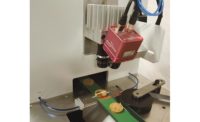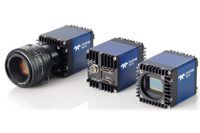
The 16-megapixel GE4900 CCD camera looks down on the X-Y table. Source: Allied Vision Technologies
Applied Scintillation Technologies (AST, Harlow, United Kingdom) is a manufacturing company that specializes in developing advanced imaging and detection systems in the dental, security, medical and health physics fields. AST has extensive experience in developing custom phosphors and scintillants, which, coupled with a charge-coupled device (CCD) or complementary metal oxide semiconductor (CMOS) cameras, are used in intra-oral and panoramic dental systems.
Digital imaging in dental surgeries is rapidly gaining ground due to its health and practical benefits for both staff and patients. Using CCD or CMOS digital cameras instead of film requires a much lower X-ray dose, allows instant images to be displayed and eliminates the need for film processing that uses potentially toxic chemicals. In addition, the ability to store digital images on computers facilitates patient record management, long-term care and treatment plans.

An improved camera system equals improved quality control of AST’s products. Source: Allied Vision Technologies
High-Precision Inspection
AST develops and manufactures imaging devices used in dental X-ray diagnostic systems. Their intra-oral device combines a CCD sensor chip with a fast response X-ray scintillator Caesium Iodide (CsI) coating optimized to eliminate potential image blur caused by patient movement during imaging.The surface quality of the 1.25 inches by 1 inch CsI-coated device requires high-precision measurement to ensure accuracy during the diagnostic stage. Because of the improvements in the structure of the deposited CsI, imperfections are getting smaller and smaller, making them difficult to detect.
AST has developed a high-quality proofing system based on an optical inspection microscope and a camera system for X-ray inspection that is used to detect small marks and imperfections in the coating structure, or any other process that may have occurred during the manufacturing stage. An improved camera system equals improved quality control of AST’s products, the majority of which are tested by X-ray.
The system uses a 16-megapixel Prosilica GE4900 CCD camera by Allied Vision Technologies (Newburyport, MA). The GE4900 has the 35-millimeter format Kodak KAI-16000 CCD image sensor that provides very high resolution as well as low noise and excellent sensitivity for applications such as X-ray imaging.
The GE4900 camera is mounted on a gantry above an X-Y table that has a movement range of 12 inches by 12 inches. The height of the camera can be adjusted with a motorized lead screw, and lens focus is remotely controlled and adjusted thanks to the use of an EF-mount adaptor. The adaptor supports a range of off-the-shelf Canon and Tamron lenses and provides motorized lens control for functions such as iris and focus control to industrial cameras.
The 100-millimeter Canon macro lens is protected from the X-rays by lead glass, and the body of the camera has a lead jacket for extra protection. Focus and aperture control are controlled via the RS-232 peripheral port of the Prosilica GE4900 camera.
The operating software used to analyze results was developed in-house by AST using the AVT/Prosilica SDK. It controls all functions including triggering, gain settings and image processing.
Ensuring High Standards
The best way to detect flaws on the X-ray-sensitive coating is to X-ray them. First, the devices are cleaned and visually inspected to ensure that all process contaminants have been removed. They are then arranged in a grid on a tray and set up on the X-Y stage. The operating software is used to select which products are tested. The program sets up the stage, camera height, exposure time, lens aperture and focus. Pressing the scan button starts the X-ray and images for each device are taken and stored.At 10 microns per pixel resolution, the new AST quality proofing system ensures high standards and quality for their intra-oral X-ray devices for fast and accurate dental diagnostics.
Allied Vision Technologies
(978) 225-2030
www.alliedvisiontec.com

